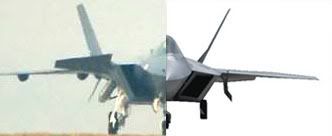Fallacy of false equivalence. You can't make a claim that so and so features balance out ergo they have the same qualities, especially when that quality you are trying to discern is not founded on the premise of parts, but the whole. 1) Drag is not purely determined by the surface areas of the feature, but also sweep, and boundary layer interaction from other parts of the airplane. 2) Overall drag is determined by 3 dimensional interaction of air over the entire plane, not just its parts. You're analyzing 2D features to determine a 3D outcome.J-20 has smaller vertical dorsal tail than the F-22:true
the F-22 has no ventral tails while the J-20 does:true
the J-20 vertical dorsal tails and ventral tails total area is close to the F-22`s vertical tail area:true
then it can not have much less drag.
Longer fuselage? We can probably say so with some certainty. Larger cross section? You'd have to convince us by taking a proper scaling of the aircraft's length, find the ratio of cross section to length, and give us a precise measurement to have any claim that's reasonably accurate. Putting them together in a split image without respect for the right scaling is not convincing. Furthermore, you're going with a frontal cross section, but the cross section changes along the length of the plane. It's a poor way to back up any claim about volume and mass.does the J-20 have a longer fuselage and larger cross section than the F-22?:yes it does
Similar=/=Same. An isosceles and equilateral triangle look similar. Will they necessarily have the same side length:area ratios? No.does the F-22 and J-20`s cross sections have similar size and shape? :yes they do
was the F-22 designed using super computers?: yes it was
Is it possible the F-22 has a design more optimized to the air dominance role?: yes it is possible
conclusion: it is more likely the J-20 is designed as an interceptor and strike aircraft that will use HMS and advanced missiles in a similar fashion to the F-35 and not to the F-22.
it will be less stealthy due to canards and size than the F-35 but will probably carry much more ordenance and longer range missiles than the F-35
Was the J-20 designed using a super computer? Yes it was.
Is it possible the J-20 has a design more optimized to the air dominance role?: yes it is possible
conclusion: it is more likely the J-20 is designed towards an air dominance role.
See what I just did there? You haven't backed your claim as to why your statements should logically lead to your conclusions that the F-22 fits one role while the J-20 fits another. Furthermore, you have not asserted an argument as to what properties make for an air dominance role. Finally, nothing you have said about the F-22 has indicated anything that categorically relegates the J-20 to a deferring role.
Last edited:



